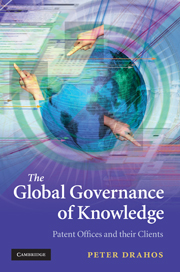Book contents
- Frontmatter
- Contents
- List of diagrams and tables
- List of abbreviations
- Preface
- 1 Patent offices and the global governance of knowledge
- 2 Labyrinths and catacombs: Patent office procedure
- 3 The rise of patent offices
- 4 The Sun and its planets: The European Patent Office and national offices
- 5 The USPTO and JPO
- 6 The age of Trilaterals and the spirit of cooperation
- 7 The jewel in the crown: India's Patent Office
- 8 The dragon and the tiger: China and South Korea
- 9 Joining the patent office conga line: Brazil
- 10 Islands and regions in the patent stream
- 11 Reclaiming the patent social contract
- 12 Patent administration sovereignty: Nodal solutions for small countries, developing countries
- Index
- References
8 - The dragon and the tiger: China and South Korea
Published online by Cambridge University Press: 03 May 2010
- Frontmatter
- Contents
- List of diagrams and tables
- List of abbreviations
- Preface
- 1 Patent offices and the global governance of knowledge
- 2 Labyrinths and catacombs: Patent office procedure
- 3 The rise of patent offices
- 4 The Sun and its planets: The European Patent Office and national offices
- 5 The USPTO and JPO
- 6 The age of Trilaterals and the spirit of cooperation
- 7 The jewel in the crown: India's Patent Office
- 8 The dragon and the tiger: China and South Korea
- 9 Joining the patent office conga line: Brazil
- 10 Islands and regions in the patent stream
- 11 Reclaiming the patent social contract
- 12 Patent administration sovereignty: Nodal solutions for small countries, developing countries
- Index
- References
Summary
Patent law in the era of decline, rebellion and war
During the nineteenth century and the early part of the twentieth century China became an increasingly decaying imperial power beset by internal rebellion and conflicts with European colonizing powers. One of these rebellions beginning in 1850 and lasting some 20 years was led by Hung Hsiu-ch'uan. A Christian believer, he declared himself the Heavenly King of the Kingdom of Heavenly Peace and led a rebellion estimated to have cost some 30 million lives. Developing a patent law was not an especially high priority in China during this time. There is a suggestion that amidst the slaughter during the time of the Kingdom of Heavenly Peace a patent law of some kind was proposed by one of the leaders of rebellion.
The Taiping rebellion was one of a number of conflicts in China in the nineteenth century, including the two Opium Wars (the first against the British in 1839–42 and the second against the British and French in 1856–60), a war with France in 1884 that saw China lose control over Indo-China and another with Japan in 1895 that saw China lose Korea and Formosa. With 1900 came the Boxer Rebellion that ended in China making many concessions to the Western powers that had captured Peking and put down the Rebellion.
- Type
- Chapter
- Information
- The Global Governance of KnowledgePatent Offices and their Clients, pp. 221 - 241Publisher: Cambridge University PressPrint publication year: 2010



